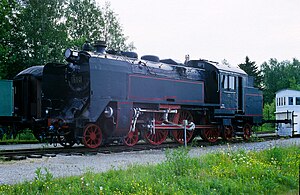
VR-Group Plc, commonly known as VR, is a government-owned railway company in Finland. VR's most important function is the operation of Finland's passenger rail services with 250 long-distance and 800 commuter rail services every day. With 7,500 employees and net sales of €1,251 million in 2017, VR is one of the most significant operators in the Finnish public transport market area.

Under the Whyte notation for the classification of steam locomotives, 0-6-0 represents the wheel arrangement of no leading wheels, six powered and coupled driving wheels on three axles and no trailing wheels. This was the most common wheel arrangement used on both tender and tank locomotives in versions with both inside and outside cylinders.

Under the Whyte notation for the classification of locomotives, 4-6-4 represents the wheel arrangement of four leading wheels, six powered and coupled driving wheels and four trailing wheels. In France where the type was first used, it is known as the Baltic while it became known as the Hudson in most of North America.

A 4-6-0 steam locomotive, under the Whyte notation for the classification of steam locomotives by wheel arrangement, has four leading wheels on two axles in a leading bogie and six powered and coupled driving wheels on three axles with the absence of trailing wheels.
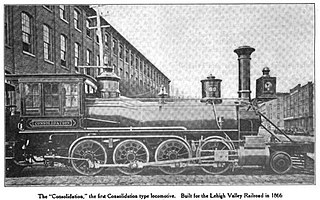
Under the Whyte notation for the classification of steam locomotives, 2-8-0 represents the wheel arrangement of two leading wheels on one axle, usually in a leading truck, eight powered and coupled driving wheels on four axles, and no trailing wheels. In the United States and elsewhere, this wheel arrangement is commonly known as a Consolidation, after the Lehigh and Mahanoy Railroad’s Consolidation, the name of the first 2-8-0.

Under the Whyte notation for the classification of steam locomotives, 0-10-0 represents the wheel arrangement of no leading wheels, ten powered and coupled driving wheels on five axles and no trailing wheels. In the United Kingdom, this type is known as a Decapod, a name which is applied to 2-10-0 types in the United States.
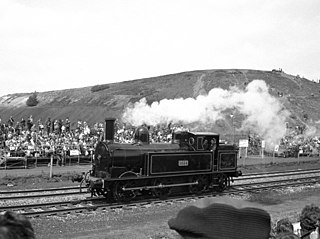
Under the Whyte notation for the classification of steam locomotives, 0-6-2 represents the wheel arrangement of no leading wheels, six powered and coupled driving wheels on three axles and two trailing wheels on one axle. The type is sometimes known as a Webb or a Branchliner.
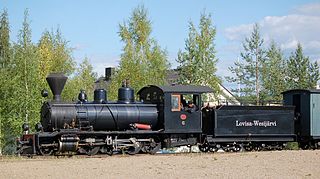
The Jokioinen Museum Railway is located in Jokioinen, Finland. It is located on the last operating commercial narrow gauge railway in Finland, the 750 mm gauge Jokioinen Railway.

The Jokioinen Railway located in Jokioinen, Finland, was opened for temporary traffic on December 9, 1898. On October 25 1899, the railway began permanent passenger and freight services.
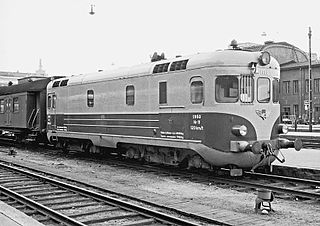
The VR Class Hr11 was the first class of line-haul diesel locomotives used by Valtionrautatiet. Only five units were built, all delivered by Valmet in 1955. The Maybach diesel engines used in the locomotives proved highly unreliable, resulting in a complete overhaul of the engine-transmission system in 1956–58, but this did not solve all of the reliability problems. The Hr11 series was withdrawn from service in 1972.

The Hr1 class was the largest passenger express steam locomotive built in Finland. Twenty-two were built between the years 1937–1957. They were numbered 1000–1021.

The Finnish VR Class Tk3 was a 2-8-0 light freight locomotive. It was the most numerous steam locomotive class in Finland with 161 built. 100 locomotives were constructed between 1927 and 1930, with a further 61 ordered and constructed 1943–53. They were numbered 800–899, 1100–1118, and 1129–1170.

VR Class Pr1 was a tank steam locomotive for local passenger services of Finnish railways.
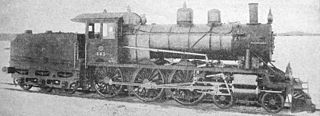
The Finnish Hv1 class was a 4-6-0 express passenger train locomotive. 42 were built between 1915 and 1921. They were numbered 545–578 and 648–655.

Before 1942 VR Class Vr1s originally had the class name was L1. The Vr1 was a powerful and effective locomotive. Part of them were built by Tampella and part by Hannoversche Maschinenbau AG of Germany. They were numbered 530–544, 656–670, 787–799 and were nicknamed “Kana” ("Hen"). They were operation from 1913-1974.

The VR Class Vr3 was a class of steam locomotive built in Finland. Before 1942, the class was known as O1. They were nicknamed Kukko and they have the same frames and boiler as the Vr Class Pr1 (Paikku) locomotive. The first locomotive was ordered in 1924 from Hanomag of Germany, number 10 351 and it was numbered 752. The remaining 4 were produced by Tampella Oy in Tampere. They were numbered 752 to 756.

The VR Class Tr1 is a class of heavy freight locomotive built in Finland and Germany. Before 1942 VR Class Tr1s originally had the class name R1. They were nicknamed “Risto”, after the Finnish President Risto Ryti. They were numbered 1030–1096.

The locomotive that came to form VR Class Vk4 was originally one of a pair of 0-4-0T locomotives ordered from Rheinmetall Borsig Lokomotiv Werke (AEG), Germany to work at Ino fortress at Terijoki on the Karelian Isthmus. The locomotives had 2 axles, they were the wet-steam type, and used a slip-Walschaert valve gear. Production numbers and years were 7268/1909 and 7858/1910. The fortress was in Finnish hands when Finland became independent.

The South West African Class Ha 0-6-2T of 1904 was a steam locomotive from the German South West Africa era.
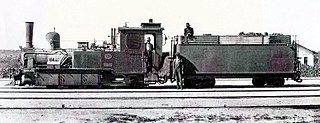
The South West African Class Hb 0-6-2T of 1905 was a narrow gauge steam locomotive from the German South West Africa era.
